Patient Care Report: Dementia Diagnosis, Interventions, and Outcomes
VerifiedAdded on 2023/04/21
|11
|2227
|271
Report
AI Summary
This report details the comprehensive care plan for a patient diagnosed with dementia, encompassing assessment, diagnosis, desired outcomes, and interventions. The assessment reveals increased confusion, memory loss, weakness, orthostatic hypotension, and fall risk. The nursing diagnosis is dementia, supported by symptoms and related studies. Desired outcomes focus on minimizing confusion and cognitive impairment. Interventions include avoiding emotionally charged situations, distraction techniques, limiting sensory stimuli, maintaining consistent scheduling, providing mobility assistance, managing fall risks, and treating orthostatic hypotension through lifestyle changes and, if necessary, medication. The report emphasizes the importance of family involvement and regular evaluation of interventions to ensure effective patient care and improved quality of life. The report references multiple studies to support the interventions and rationale.

Assessment Nursing Diagnosis Desired Outcomes\goals\
planning
Interventions with
rationale/implementation
Evaluation of
Interventions
Subjective data
The subjective assessments
that were conducted when
the patient was presented in
the healthcare center were
increased confusion, loss of
memory as well as
weakness.
Objective data
After the nursing
professional conducted the
objective assessments, it
was found that the patient
also suffered orthostatic
hypotension along with loss
of cognitive ability.
Moreover, risks of fall were
also observed within the
patient.
Studies are of the opinion
that early signs of memory
problems particularly
remembering particular
events along with
increased confusion and
reduced concentration are
associated with dementia
(Cabera et al., 2015).
Some of the warning
symptoms like memory
loss, disorientation, poor
judgment and spatial skills
along with misplacing
things are also symptoms
of dementia. In the case of
the patient, it was seen that
he is suffering from
memory loss, confusion,
high chances of fall and
similar symptoms have
been found. Hence, the
patient is diagnosed to be
suffering from dementia.
Moreover studies also
relate orthostatic
hypotension as an
It is important for the patient to
handle everyday occurrences
successfully by reducing the
amount of frustration resulting
from chronic confusion. The
patient will have minimal
confusion, cognitive
impairment and other dementia
manifestations
The nurse should try to avoid
and terminate emotionally
charged up situations as well
as conversations. The nurse
should also try to avoid anger
and expectation of the patient
in remembering or following
instructions. Nurses should
never expect more than the
patient is able to perform.
The main rationale is to be
discussed. Catastrophic
emotional response can result
from task failure when the
patient feel that he is
expected to perform beyond
ability and becomes angry as
well as frustrated. Studies
opine that responding calmly
to the patient will help in
validating the feeling and
cause less stress in patients
(Eritz et al., 2016).
Families should be
instructed to avoid arguing
with the patient about what he
thinks, sees or hears. The
main rationale is that patients
Different tools should be
used for evaluating and
estimating level of
confusion. This would
help in indicating the
effectiveness of treatment
as well as declining of the
condition.
planning
Interventions with
rationale/implementation
Evaluation of
Interventions
Subjective data
The subjective assessments
that were conducted when
the patient was presented in
the healthcare center were
increased confusion, loss of
memory as well as
weakness.
Objective data
After the nursing
professional conducted the
objective assessments, it
was found that the patient
also suffered orthostatic
hypotension along with loss
of cognitive ability.
Moreover, risks of fall were
also observed within the
patient.
Studies are of the opinion
that early signs of memory
problems particularly
remembering particular
events along with
increased confusion and
reduced concentration are
associated with dementia
(Cabera et al., 2015).
Some of the warning
symptoms like memory
loss, disorientation, poor
judgment and spatial skills
along with misplacing
things are also symptoms
of dementia. In the case of
the patient, it was seen that
he is suffering from
memory loss, confusion,
high chances of fall and
similar symptoms have
been found. Hence, the
patient is diagnosed to be
suffering from dementia.
Moreover studies also
relate orthostatic
hypotension as an
It is important for the patient to
handle everyday occurrences
successfully by reducing the
amount of frustration resulting
from chronic confusion. The
patient will have minimal
confusion, cognitive
impairment and other dementia
manifestations
The nurse should try to avoid
and terminate emotionally
charged up situations as well
as conversations. The nurse
should also try to avoid anger
and expectation of the patient
in remembering or following
instructions. Nurses should
never expect more than the
patient is able to perform.
The main rationale is to be
discussed. Catastrophic
emotional response can result
from task failure when the
patient feel that he is
expected to perform beyond
ability and becomes angry as
well as frustrated. Studies
opine that responding calmly
to the patient will help in
validating the feeling and
cause less stress in patients
(Eritz et al., 2016).
Families should be
instructed to avoid arguing
with the patient about what he
thinks, sees or hears. The
main rationale is that patients
Different tools should be
used for evaluating and
estimating level of
confusion. This would
help in indicating the
effectiveness of treatment
as well as declining of the
condition.
Paraphrase This Document
Need a fresh take? Get an instant paraphrase of this document with our AI Paraphraser
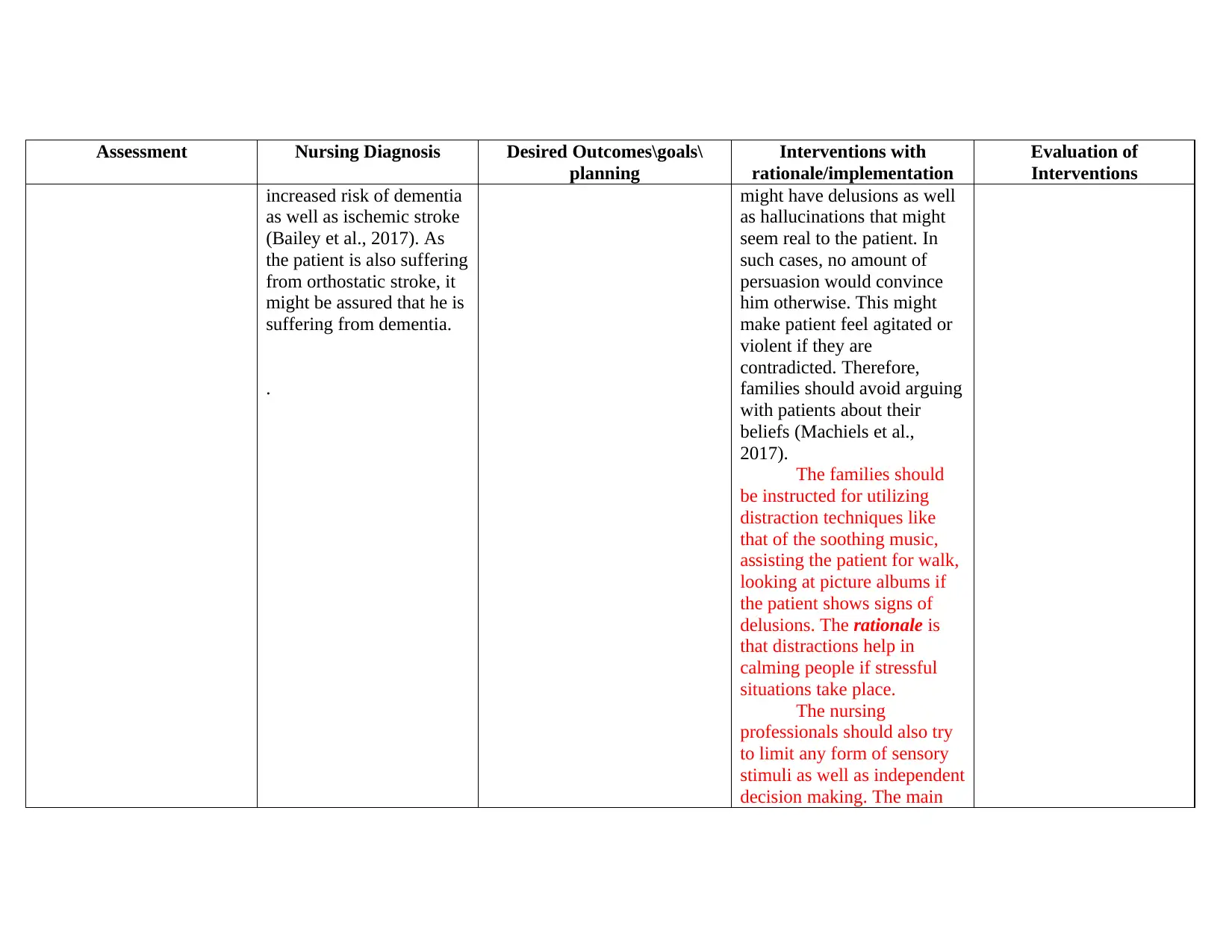
Assessment Nursing Diagnosis Desired Outcomes\goals\
planning
Interventions with
rationale/implementation
Evaluation of
Interventions
increased risk of dementia
as well as ischemic stroke
(Bailey et al., 2017). As
the patient is also suffering
from orthostatic stroke, it
might be assured that he is
suffering from dementia.
.
might have delusions as well
as hallucinations that might
seem real to the patient. In
such cases, no amount of
persuasion would convince
him otherwise. This might
make patient feel agitated or
violent if they are
contradicted. Therefore,
families should avoid arguing
with patients about their
beliefs (Machiels et al.,
2017).
The families should
be instructed for utilizing
distraction techniques like
that of the soothing music,
assisting the patient for walk,
looking at picture albums if
the patient shows signs of
delusions. The rationale is
that distractions help in
calming people if stressful
situations take place.
The nursing
professionals should also try
to limit any form of sensory
stimuli as well as independent
decision making. The main
planning
Interventions with
rationale/implementation
Evaluation of
Interventions
increased risk of dementia
as well as ischemic stroke
(Bailey et al., 2017). As
the patient is also suffering
from orthostatic stroke, it
might be assured that he is
suffering from dementia.
.
might have delusions as well
as hallucinations that might
seem real to the patient. In
such cases, no amount of
persuasion would convince
him otherwise. This might
make patient feel agitated or
violent if they are
contradicted. Therefore,
families should avoid arguing
with patients about their
beliefs (Machiels et al.,
2017).
The families should
be instructed for utilizing
distraction techniques like
that of the soothing music,
assisting the patient for walk,
looking at picture albums if
the patient shows signs of
delusions. The rationale is
that distractions help in
calming people if stressful
situations take place.
The nursing
professionals should also try
to limit any form of sensory
stimuli as well as independent
decision making. The main
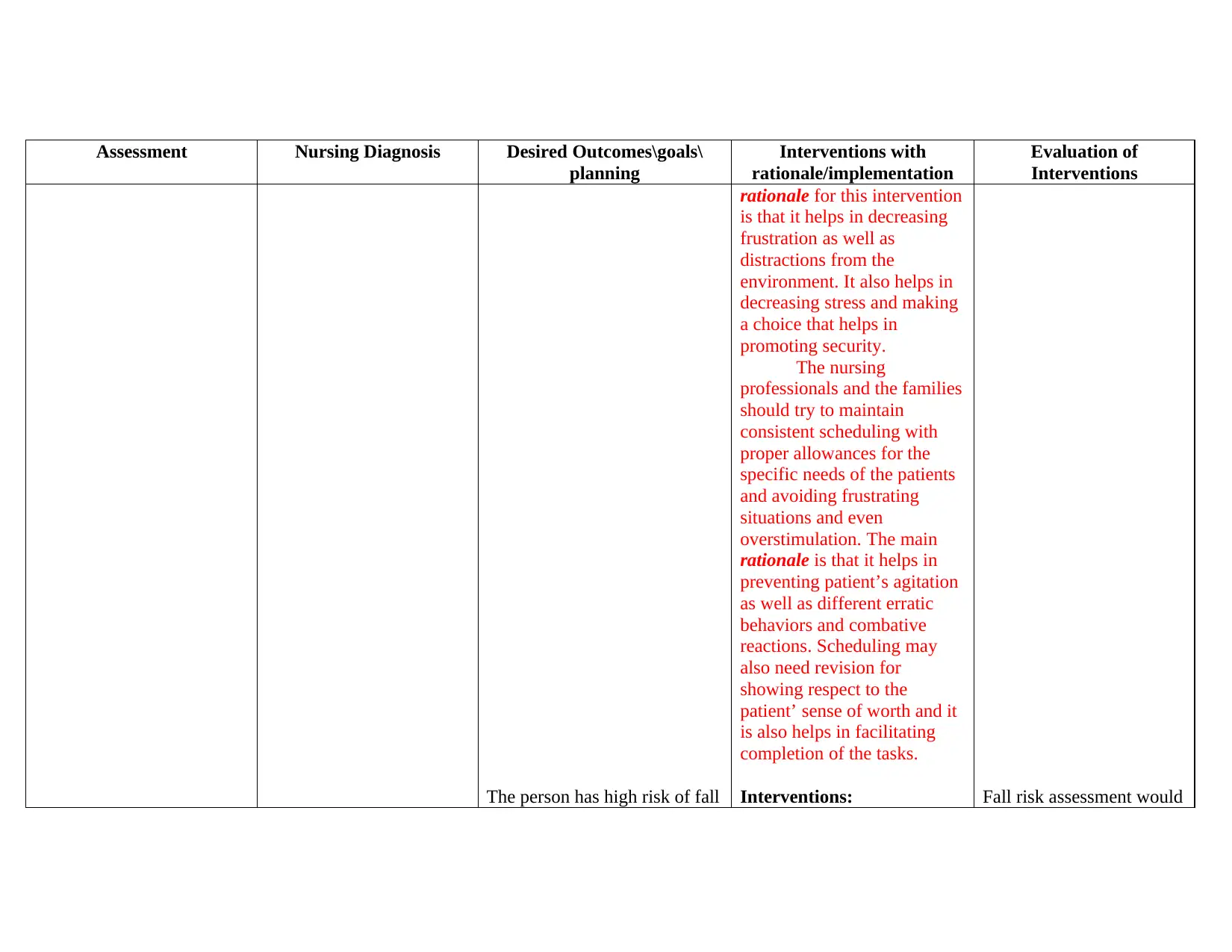
Assessment Nursing Diagnosis Desired Outcomes\goals\
planning
Interventions with
rationale/implementation
Evaluation of
Interventions
The person has high risk of fall
rationale for this intervention
is that it helps in decreasing
frustration as well as
distractions from the
environment. It also helps in
decreasing stress and making
a choice that helps in
promoting security.
The nursing
professionals and the families
should try to maintain
consistent scheduling with
proper allowances for the
specific needs of the patients
and avoiding frustrating
situations and even
overstimulation. The main
rationale is that it helps in
preventing patient’s agitation
as well as different erratic
behaviors and combative
reactions. Scheduling may
also need revision for
showing respect to the
patient’ sense of worth and it
is also helps in facilitating
completion of the tasks.
Interventions: Fall risk assessment would
planning
Interventions with
rationale/implementation
Evaluation of
Interventions
The person has high risk of fall
rationale for this intervention
is that it helps in decreasing
frustration as well as
distractions from the
environment. It also helps in
decreasing stress and making
a choice that helps in
promoting security.
The nursing
professionals and the families
should try to maintain
consistent scheduling with
proper allowances for the
specific needs of the patients
and avoiding frustrating
situations and even
overstimulation. The main
rationale is that it helps in
preventing patient’s agitation
as well as different erratic
behaviors and combative
reactions. Scheduling may
also need revision for
showing respect to the
patient’ sense of worth and it
is also helps in facilitating
completion of the tasks.
Interventions: Fall risk assessment would
⊘ This is a preview!⊘
Do you want full access?
Subscribe today to unlock all pages.

Trusted by 1+ million students worldwide
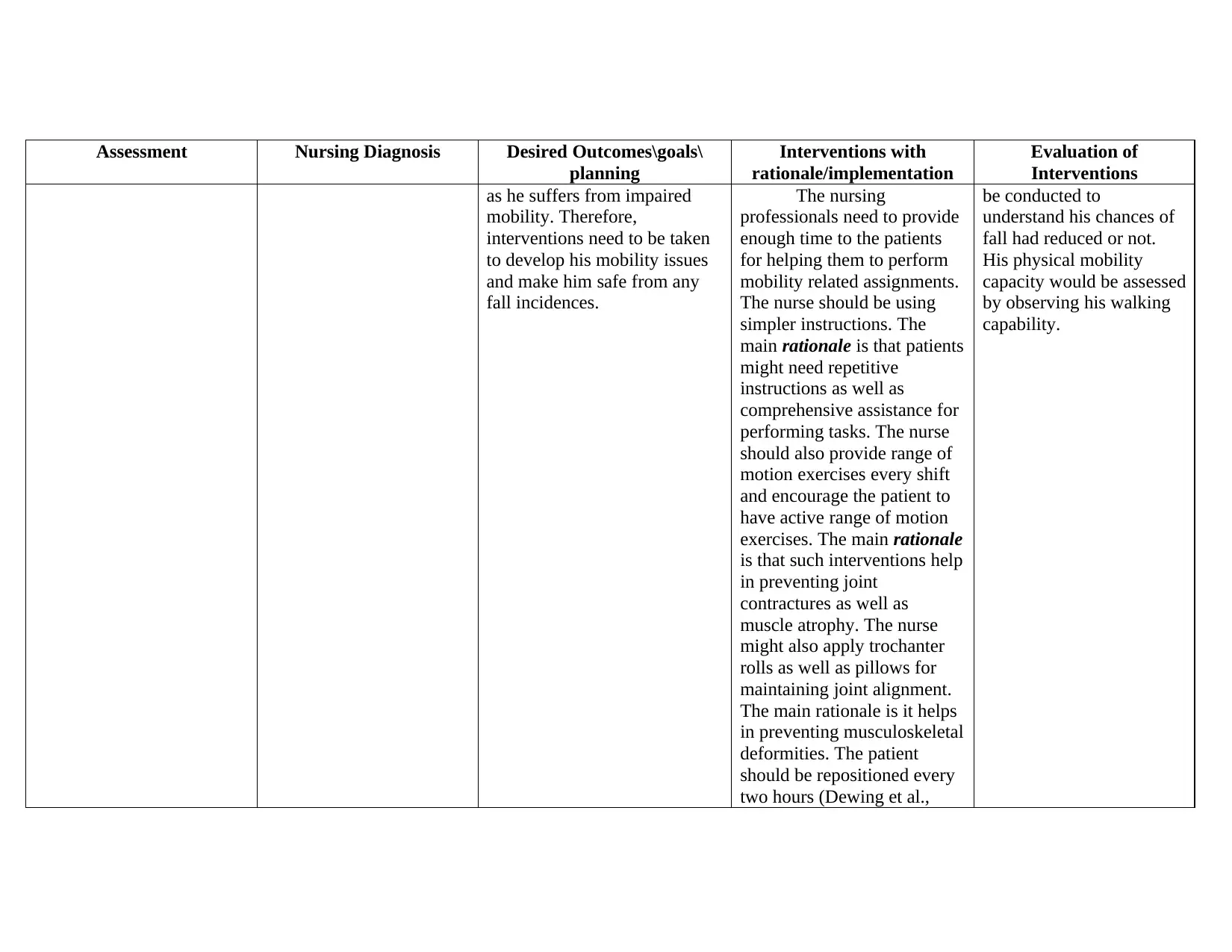
Assessment Nursing Diagnosis Desired Outcomes\goals\
planning
Interventions with
rationale/implementation
Evaluation of
Interventions
as he suffers from impaired
mobility. Therefore,
interventions need to be taken
to develop his mobility issues
and make him safe from any
fall incidences.
The nursing
professionals need to provide
enough time to the patients
for helping them to perform
mobility related assignments.
The nurse should be using
simpler instructions. The
main rationale is that patients
might need repetitive
instructions as well as
comprehensive assistance for
performing tasks. The nurse
should also provide range of
motion exercises every shift
and encourage the patient to
have active range of motion
exercises. The main rationale
is that such interventions help
in preventing joint
contractures as well as
muscle atrophy. The nurse
might also apply trochanter
rolls as well as pillows for
maintaining joint alignment.
The main rationale is it helps
in preventing musculoskeletal
deformities. The patient
should be repositioned every
two hours (Dewing et al.,
be conducted to
understand his chances of
fall had reduced or not.
His physical mobility
capacity would be assessed
by observing his walking
capability.
planning
Interventions with
rationale/implementation
Evaluation of
Interventions
as he suffers from impaired
mobility. Therefore,
interventions need to be taken
to develop his mobility issues
and make him safe from any
fall incidences.
The nursing
professionals need to provide
enough time to the patients
for helping them to perform
mobility related assignments.
The nurse should be using
simpler instructions. The
main rationale is that patients
might need repetitive
instructions as well as
comprehensive assistance for
performing tasks. The nurse
should also provide range of
motion exercises every shift
and encourage the patient to
have active range of motion
exercises. The main rationale
is that such interventions help
in preventing joint
contractures as well as
muscle atrophy. The nurse
might also apply trochanter
rolls as well as pillows for
maintaining joint alignment.
The main rationale is it helps
in preventing musculoskeletal
deformities. The patient
should be repositioned every
two hours (Dewing et al.,
be conducted to
understand his chances of
fall had reduced or not.
His physical mobility
capacity would be assessed
by observing his walking
capability.
Paraphrase This Document
Need a fresh take? Get an instant paraphrase of this document with our AI Paraphraser
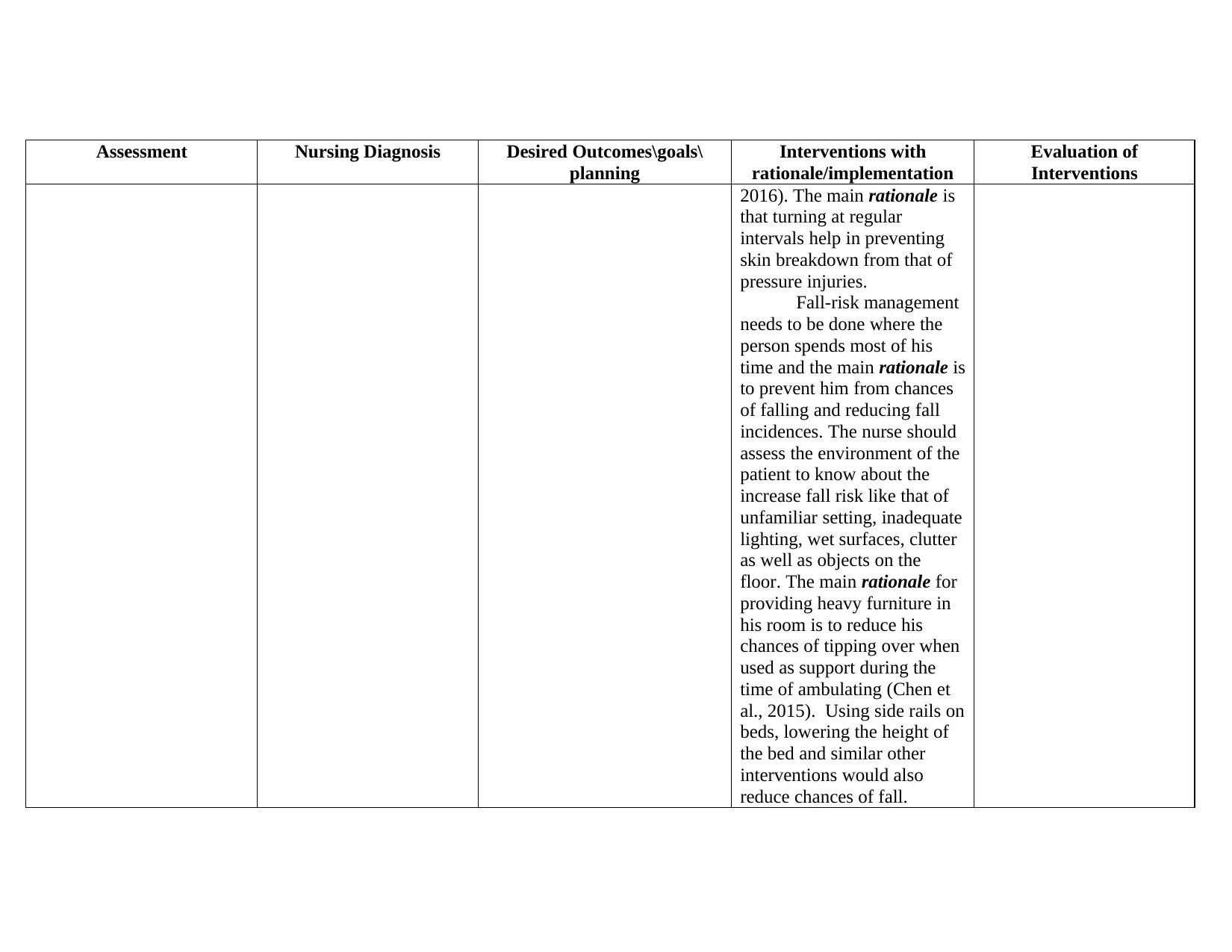
Assessment Nursing Diagnosis Desired Outcomes\goals\
planning
Interventions with
rationale/implementation
Evaluation of
Interventions
2016). The main rationale is
that turning at regular
intervals help in preventing
skin breakdown from that of
pressure injuries.
Fall-risk management
needs to be done where the
person spends most of his
time and the main rationale is
to prevent him from chances
of falling and reducing fall
incidences. The nurse should
assess the environment of the
patient to know about the
increase fall risk like that of
unfamiliar setting, inadequate
lighting, wet surfaces, clutter
as well as objects on the
floor. The main rationale for
providing heavy furniture in
his room is to reduce his
chances of tipping over when
used as support during the
time of ambulating (Chen et
al., 2015). Using side rails on
beds, lowering the height of
the bed and similar other
interventions would also
reduce chances of fall.
planning
Interventions with
rationale/implementation
Evaluation of
Interventions
2016). The main rationale is
that turning at regular
intervals help in preventing
skin breakdown from that of
pressure injuries.
Fall-risk management
needs to be done where the
person spends most of his
time and the main rationale is
to prevent him from chances
of falling and reducing fall
incidences. The nurse should
assess the environment of the
patient to know about the
increase fall risk like that of
unfamiliar setting, inadequate
lighting, wet surfaces, clutter
as well as objects on the
floor. The main rationale for
providing heavy furniture in
his room is to reduce his
chances of tipping over when
used as support during the
time of ambulating (Chen et
al., 2015). Using side rails on
beds, lowering the height of
the bed and similar other
interventions would also
reduce chances of fall.
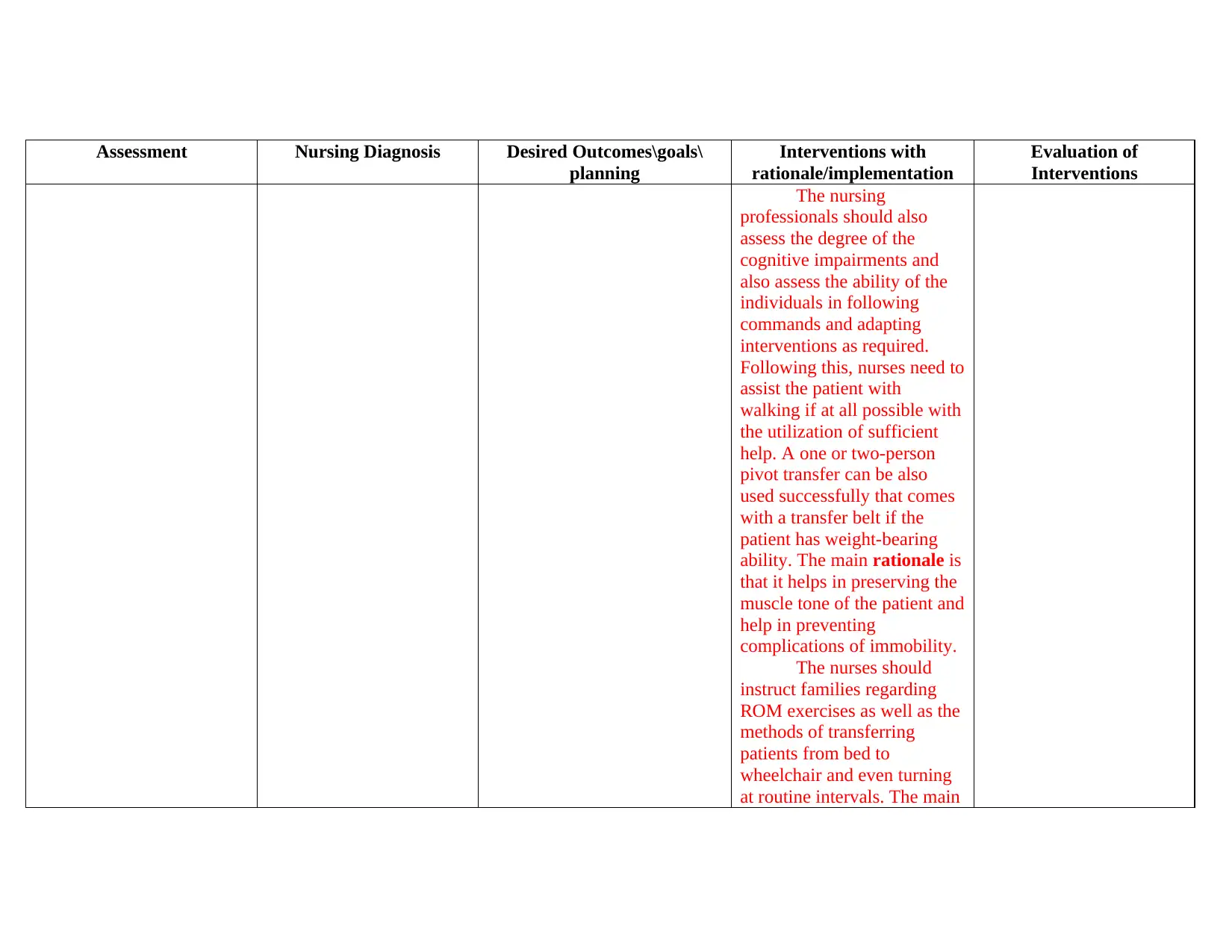
Assessment Nursing Diagnosis Desired Outcomes\goals\
planning
Interventions with
rationale/implementation
Evaluation of
Interventions
The nursing
professionals should also
assess the degree of the
cognitive impairments and
also assess the ability of the
individuals in following
commands and adapting
interventions as required.
Following this, nurses need to
assist the patient with
walking if at all possible with
the utilization of sufficient
help. A one or two-person
pivot transfer can be also
used successfully that comes
with a transfer belt if the
patient has weight-bearing
ability. The main rationale is
that it helps in preserving the
muscle tone of the patient and
help in preventing
complications of immobility.
The nurses should
instruct families regarding
ROM exercises as well as the
methods of transferring
patients from bed to
wheelchair and even turning
at routine intervals. The main
planning
Interventions with
rationale/implementation
Evaluation of
Interventions
The nursing
professionals should also
assess the degree of the
cognitive impairments and
also assess the ability of the
individuals in following
commands and adapting
interventions as required.
Following this, nurses need to
assist the patient with
walking if at all possible with
the utilization of sufficient
help. A one or two-person
pivot transfer can be also
used successfully that comes
with a transfer belt if the
patient has weight-bearing
ability. The main rationale is
that it helps in preserving the
muscle tone of the patient and
help in preventing
complications of immobility.
The nurses should
instruct families regarding
ROM exercises as well as the
methods of transferring
patients from bed to
wheelchair and even turning
at routine intervals. The main
⊘ This is a preview!⊘
Do you want full access?
Subscribe today to unlock all pages.

Trusted by 1+ million students worldwide
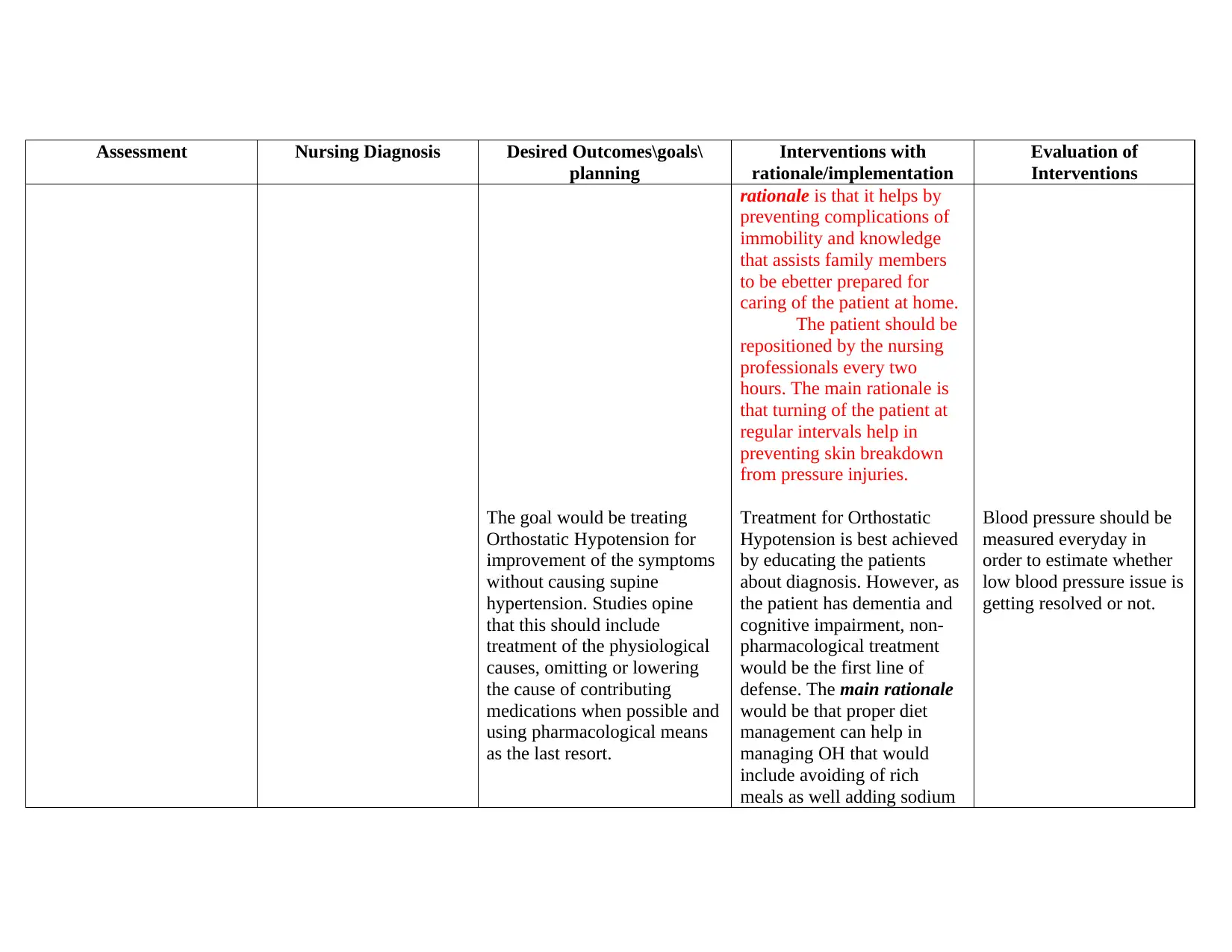
Assessment Nursing Diagnosis Desired Outcomes\goals\
planning
Interventions with
rationale/implementation
Evaluation of
Interventions
The goal would be treating
Orthostatic Hypotension for
improvement of the symptoms
without causing supine
hypertension. Studies opine
that this should include
treatment of the physiological
causes, omitting or lowering
the cause of contributing
medications when possible and
using pharmacological means
as the last resort.
rationale is that it helps by
preventing complications of
immobility and knowledge
that assists family members
to be ebetter prepared for
caring of the patient at home.
The patient should be
repositioned by the nursing
professionals every two
hours. The main rationale is
that turning of the patient at
regular intervals help in
preventing skin breakdown
from pressure injuries.
Treatment for Orthostatic
Hypotension is best achieved
by educating the patients
about diagnosis. However, as
the patient has dementia and
cognitive impairment, non-
pharmacological treatment
would be the first line of
defense. The main rationale
would be that proper diet
management can help in
managing OH that would
include avoiding of rich
meals as well adding sodium
Blood pressure should be
measured everyday in
order to estimate whether
low blood pressure issue is
getting resolved or not.
planning
Interventions with
rationale/implementation
Evaluation of
Interventions
The goal would be treating
Orthostatic Hypotension for
improvement of the symptoms
without causing supine
hypertension. Studies opine
that this should include
treatment of the physiological
causes, omitting or lowering
the cause of contributing
medications when possible and
using pharmacological means
as the last resort.
rationale is that it helps by
preventing complications of
immobility and knowledge
that assists family members
to be ebetter prepared for
caring of the patient at home.
The patient should be
repositioned by the nursing
professionals every two
hours. The main rationale is
that turning of the patient at
regular intervals help in
preventing skin breakdown
from pressure injuries.
Treatment for Orthostatic
Hypotension is best achieved
by educating the patients
about diagnosis. However, as
the patient has dementia and
cognitive impairment, non-
pharmacological treatment
would be the first line of
defense. The main rationale
would be that proper diet
management can help in
managing OH that would
include avoiding of rich
meals as well adding sodium
Blood pressure should be
measured everyday in
order to estimate whether
low blood pressure issue is
getting resolved or not.
Paraphrase This Document
Need a fresh take? Get an instant paraphrase of this document with our AI Paraphraser
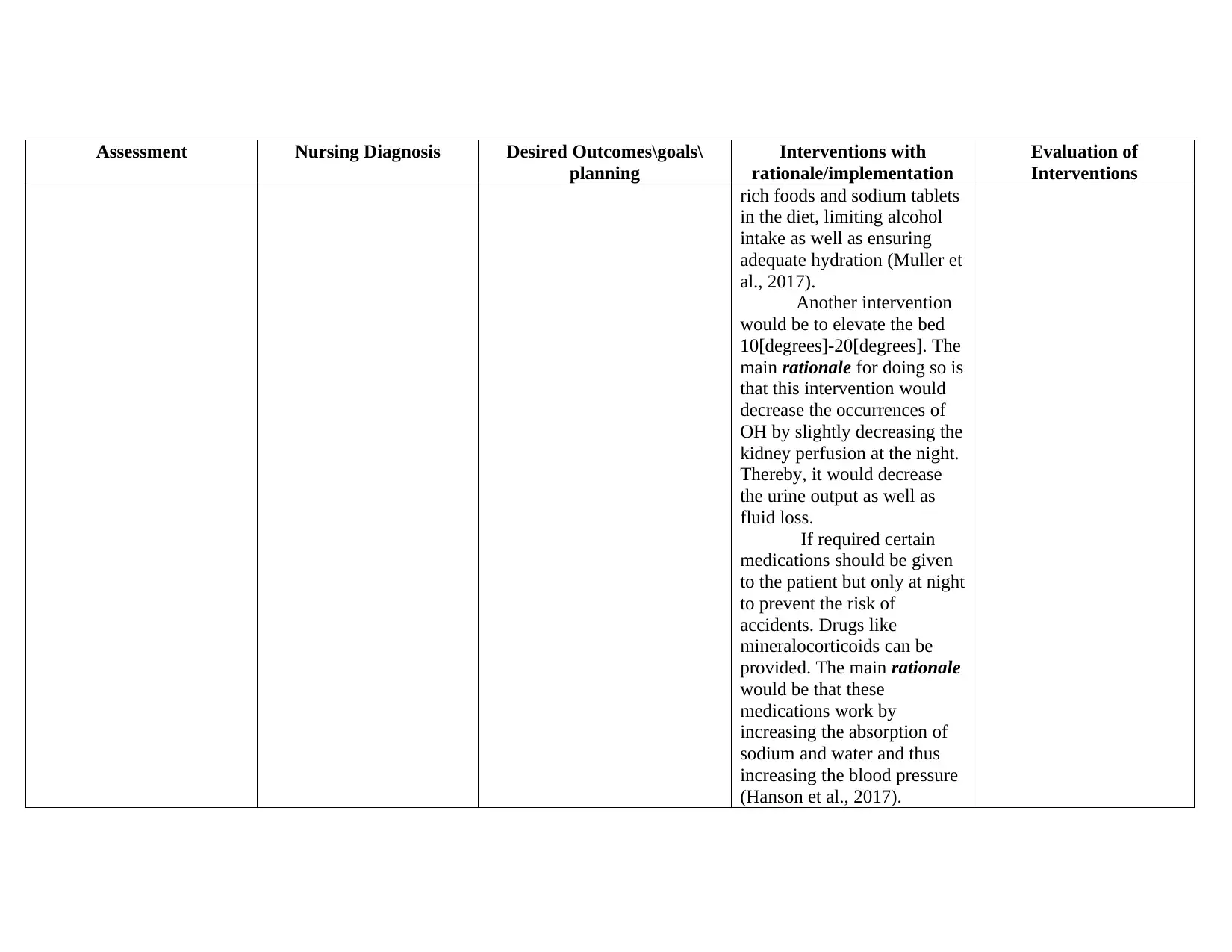
Assessment Nursing Diagnosis Desired Outcomes\goals\
planning
Interventions with
rationale/implementation
Evaluation of
Interventions
rich foods and sodium tablets
in the diet, limiting alcohol
intake as well as ensuring
adequate hydration (Muller et
al., 2017).
Another intervention
would be to elevate the bed
10[degrees]-20[degrees]. The
main rationale for doing so is
that this intervention would
decrease the occurrences of
OH by slightly decreasing the
kidney perfusion at the night.
Thereby, it would decrease
the urine output as well as
fluid loss.
If required certain
medications should be given
to the patient but only at night
to prevent the risk of
accidents. Drugs like
mineralocorticoids can be
provided. The main rationale
would be that these
medications work by
increasing the absorption of
sodium and water and thus
increasing the blood pressure
(Hanson et al., 2017).
planning
Interventions with
rationale/implementation
Evaluation of
Interventions
rich foods and sodium tablets
in the diet, limiting alcohol
intake as well as ensuring
adequate hydration (Muller et
al., 2017).
Another intervention
would be to elevate the bed
10[degrees]-20[degrees]. The
main rationale for doing so is
that this intervention would
decrease the occurrences of
OH by slightly decreasing the
kidney perfusion at the night.
Thereby, it would decrease
the urine output as well as
fluid loss.
If required certain
medications should be given
to the patient but only at night
to prevent the risk of
accidents. Drugs like
mineralocorticoids can be
provided. The main rationale
would be that these
medications work by
increasing the absorption of
sodium and water and thus
increasing the blood pressure
(Hanson et al., 2017).
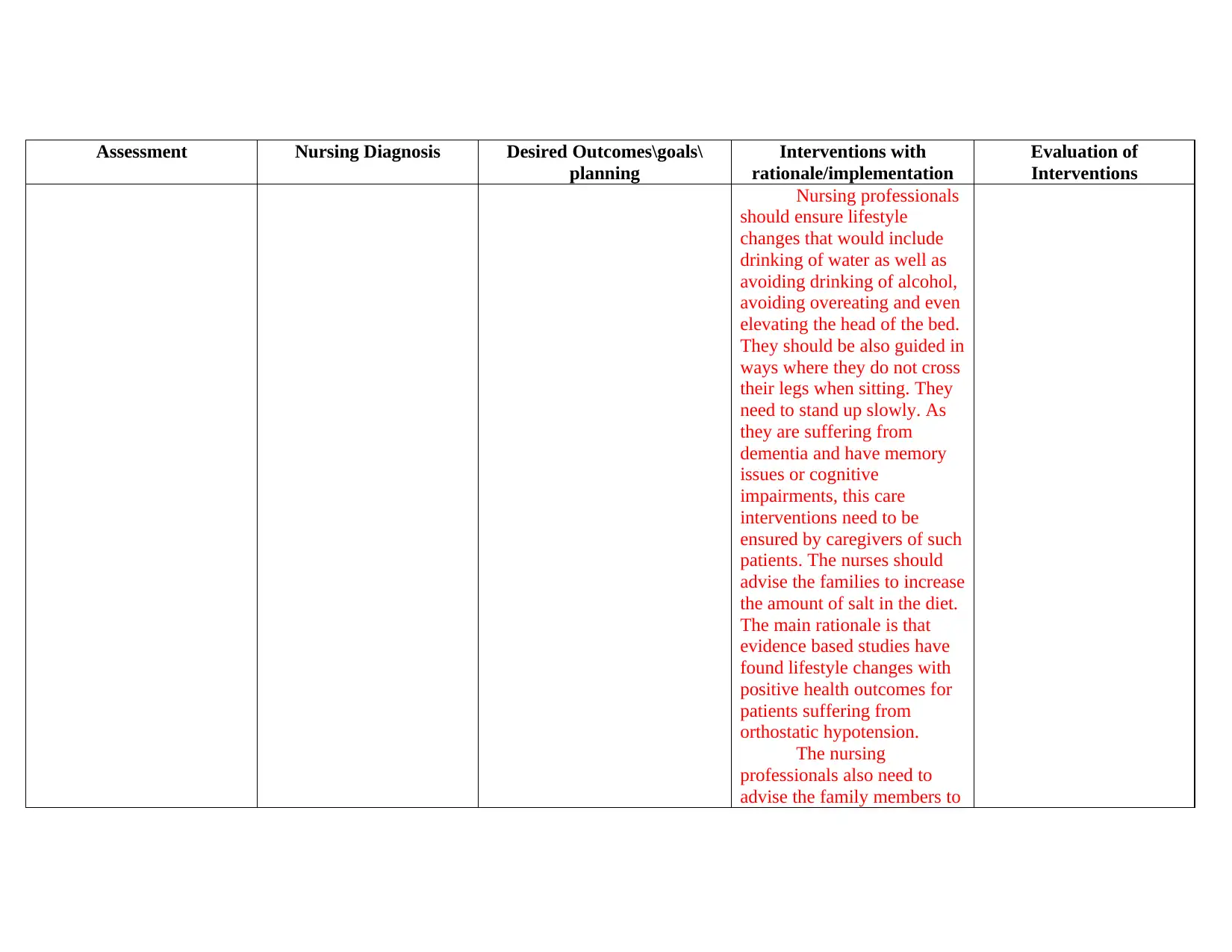
Assessment Nursing Diagnosis Desired Outcomes\goals\
planning
Interventions with
rationale/implementation
Evaluation of
Interventions
Nursing professionals
should ensure lifestyle
changes that would include
drinking of water as well as
avoiding drinking of alcohol,
avoiding overeating and even
elevating the head of the bed.
They should be also guided in
ways where they do not cross
their legs when sitting. They
need to stand up slowly. As
they are suffering from
dementia and have memory
issues or cognitive
impairments, this care
interventions need to be
ensured by caregivers of such
patients. The nurses should
advise the families to increase
the amount of salt in the diet.
The main rationale is that
evidence based studies have
found lifestyle changes with
positive health outcomes for
patients suffering from
orthostatic hypotension.
The nursing
professionals also need to
advise the family members to
planning
Interventions with
rationale/implementation
Evaluation of
Interventions
Nursing professionals
should ensure lifestyle
changes that would include
drinking of water as well as
avoiding drinking of alcohol,
avoiding overeating and even
elevating the head of the bed.
They should be also guided in
ways where they do not cross
their legs when sitting. They
need to stand up slowly. As
they are suffering from
dementia and have memory
issues or cognitive
impairments, this care
interventions need to be
ensured by caregivers of such
patients. The nurses should
advise the families to increase
the amount of salt in the diet.
The main rationale is that
evidence based studies have
found lifestyle changes with
positive health outcomes for
patients suffering from
orthostatic hypotension.
The nursing
professionals also need to
advise the family members to
⊘ This is a preview!⊘
Do you want full access?
Subscribe today to unlock all pages.

Trusted by 1+ million students worldwide
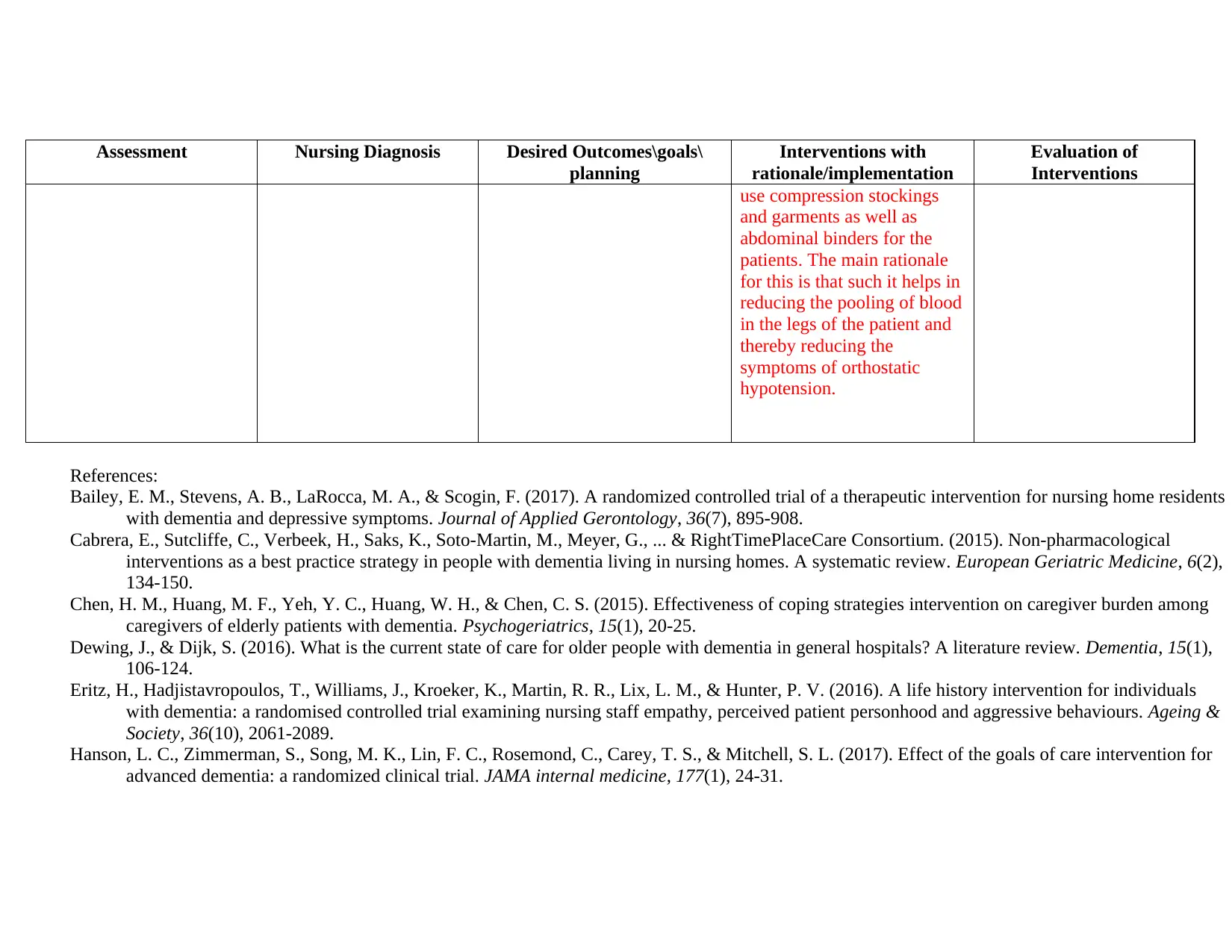
Assessment Nursing Diagnosis Desired Outcomes\goals\
planning
Interventions with
rationale/implementation
Evaluation of
Interventions
use compression stockings
and garments as well as
abdominal binders for the
patients. The main rationale
for this is that such it helps in
reducing the pooling of blood
in the legs of the patient and
thereby reducing the
symptoms of orthostatic
hypotension.
References:
Bailey, E. M., Stevens, A. B., LaRocca, M. A., & Scogin, F. (2017). A randomized controlled trial of a therapeutic intervention for nursing home residents
with dementia and depressive symptoms. Journal of Applied Gerontology, 36(7), 895-908.
Cabrera, E., Sutcliffe, C., Verbeek, H., Saks, K., Soto-Martin, M., Meyer, G., ... & RightTimePlaceCare Consortium. (2015). Non-pharmacological
interventions as a best practice strategy in people with dementia living in nursing homes. A systematic review. European Geriatric Medicine, 6(2),
134-150.
Chen, H. M., Huang, M. F., Yeh, Y. C., Huang, W. H., & Chen, C. S. (2015). Effectiveness of coping strategies intervention on caregiver burden among
caregivers of elderly patients with dementia. Psychogeriatrics, 15(1), 20-25.
Dewing, J., & Dijk, S. (2016). What is the current state of care for older people with dementia in general hospitals? A literature review. Dementia, 15(1),
106-124.
Eritz, H., Hadjistavropoulos, T., Williams, J., Kroeker, K., Martin, R. R., Lix, L. M., & Hunter, P. V. (2016). A life history intervention for individuals
with dementia: a randomised controlled trial examining nursing staff empathy, perceived patient personhood and aggressive behaviours. Ageing &
Society, 36(10), 2061-2089.
Hanson, L. C., Zimmerman, S., Song, M. K., Lin, F. C., Rosemond, C., Carey, T. S., & Mitchell, S. L. (2017). Effect of the goals of care intervention for
advanced dementia: a randomized clinical trial. JAMA internal medicine, 177(1), 24-31.
planning
Interventions with
rationale/implementation
Evaluation of
Interventions
use compression stockings
and garments as well as
abdominal binders for the
patients. The main rationale
for this is that such it helps in
reducing the pooling of blood
in the legs of the patient and
thereby reducing the
symptoms of orthostatic
hypotension.
References:
Bailey, E. M., Stevens, A. B., LaRocca, M. A., & Scogin, F. (2017). A randomized controlled trial of a therapeutic intervention for nursing home residents
with dementia and depressive symptoms. Journal of Applied Gerontology, 36(7), 895-908.
Cabrera, E., Sutcliffe, C., Verbeek, H., Saks, K., Soto-Martin, M., Meyer, G., ... & RightTimePlaceCare Consortium. (2015). Non-pharmacological
interventions as a best practice strategy in people with dementia living in nursing homes. A systematic review. European Geriatric Medicine, 6(2),
134-150.
Chen, H. M., Huang, M. F., Yeh, Y. C., Huang, W. H., & Chen, C. S. (2015). Effectiveness of coping strategies intervention on caregiver burden among
caregivers of elderly patients with dementia. Psychogeriatrics, 15(1), 20-25.
Dewing, J., & Dijk, S. (2016). What is the current state of care for older people with dementia in general hospitals? A literature review. Dementia, 15(1),
106-124.
Eritz, H., Hadjistavropoulos, T., Williams, J., Kroeker, K., Martin, R. R., Lix, L. M., & Hunter, P. V. (2016). A life history intervention for individuals
with dementia: a randomised controlled trial examining nursing staff empathy, perceived patient personhood and aggressive behaviours. Ageing &
Society, 36(10), 2061-2089.
Hanson, L. C., Zimmerman, S., Song, M. K., Lin, F. C., Rosemond, C., Carey, T. S., & Mitchell, S. L. (2017). Effect of the goals of care intervention for
advanced dementia: a randomized clinical trial. JAMA internal medicine, 177(1), 24-31.
Paraphrase This Document
Need a fresh take? Get an instant paraphrase of this document with our AI Paraphraser
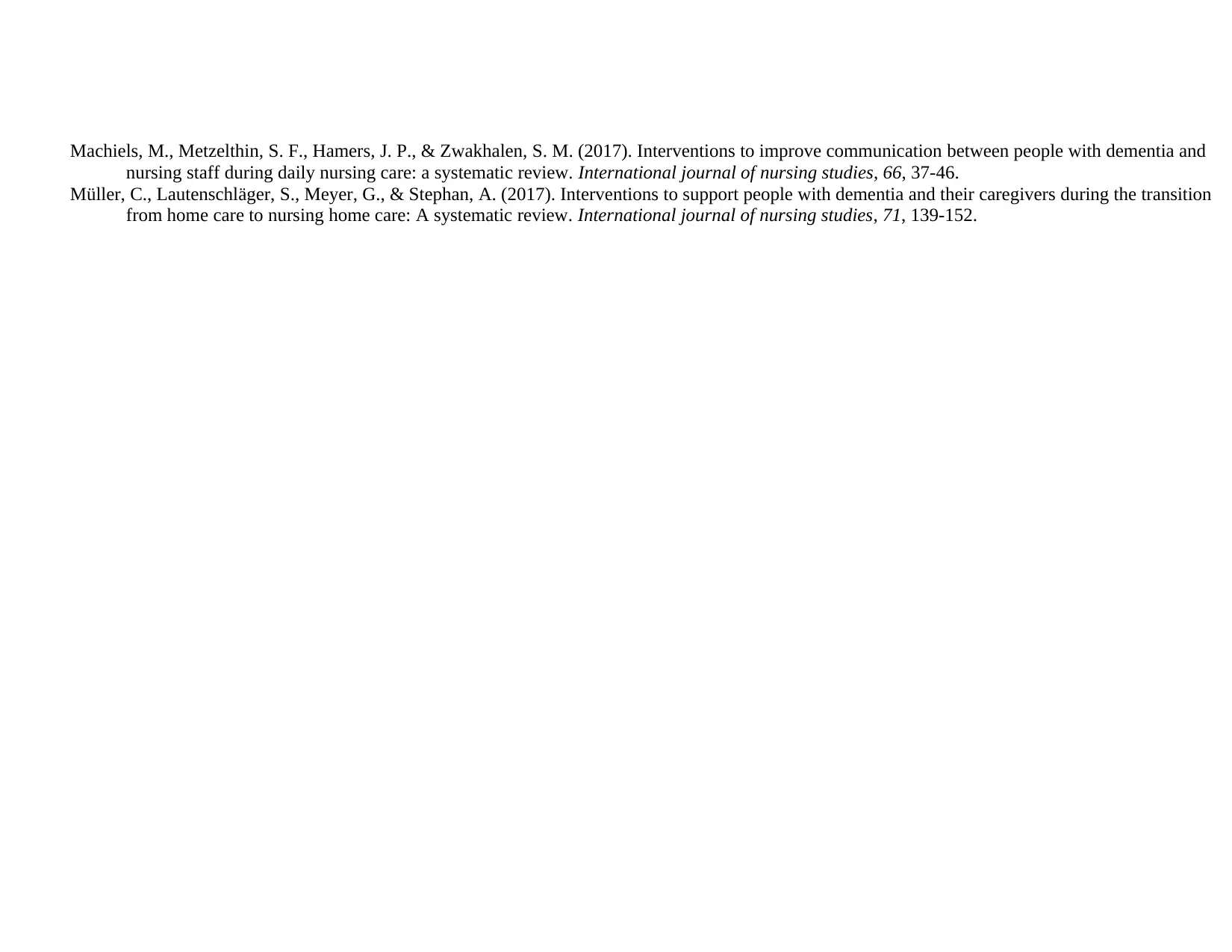
Machiels, M., Metzelthin, S. F., Hamers, J. P., & Zwakhalen, S. M. (2017). Interventions to improve communication between people with dementia and
nursing staff during daily nursing care: a systematic review. International journal of nursing studies, 66, 37-46.
Müller, C., Lautenschläger, S., Meyer, G., & Stephan, A. (2017). Interventions to support people with dementia and their caregivers during the transition
from home care to nursing home care: A systematic review. International journal of nursing studies, 71, 139-152.
nursing staff during daily nursing care: a systematic review. International journal of nursing studies, 66, 37-46.
Müller, C., Lautenschläger, S., Meyer, G., & Stephan, A. (2017). Interventions to support people with dementia and their caregivers during the transition
from home care to nursing home care: A systematic review. International journal of nursing studies, 71, 139-152.
1 out of 11
Related Documents
Your All-in-One AI-Powered Toolkit for Academic Success.
+13062052269
info@desklib.com
Available 24*7 on WhatsApp / Email
![[object Object]](/_next/static/media/star-bottom.7253800d.svg)
Unlock your academic potential
Copyright © 2020–2025 A2Z Services. All Rights Reserved. Developed and managed by ZUCOL.





